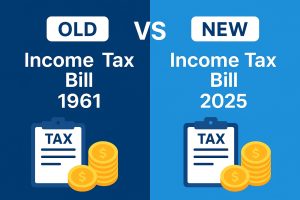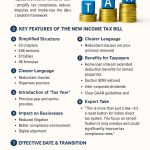The Income Tax Bill, 2025, tabled in Parliament on August 11, marks the most significant revamp of India’s direct taxation system in over six decades. Replacing the Income Tax Act, 1961, the new law aims to make taxation simpler, fairer, and more transparent. But what exactly has changed? And how does it affect you? Let’s break it down.

1. Why the Change Was Needed
For years, the 1961 law had been amended countless times, resulting in a patchwork of provisions that were difficult for ordinary taxpayers to understand. Taxpayers often had to depend on consultants just to figure out their obligations.
The new Income Tax Bill, 2025 is designed with:
- Simplified language
- Fewer exemptions but lower rates
- Faster dispute resolution
- Digital-first compliance
2. Key Changes in the New Income Tax Law
Here are the major reforms introduced in the 2025 bill:
a) Uniform “Tax Year”
The assessment year and financial year will now be merged into a single “Tax Year”. Tax returns will be filed for the same year in which the income is earned, reducing confusion.
b) Fewer Slabs, Lower Rates
The government has reduced the number of tax slabs from six to four, making the structure cleaner:
| Annual Income | Old Regime (1961 Act) | New Regime (2025 Bill) |
|---|---|---|
| Up to ₹3 lakh | Nil | Nil |
| ₹3 lakh – ₹7 lakh | 5% | 5% |
| ₹7 lakh – ₹15 lakh | 10%, 15%, 20% (varied) | 10% |
| Above ₹15 lakh | 30% | 20% |
Note: Surcharge rates have also been rationalized, and cess applicability remains.
c) Extended Deductions for Home Loans
- Old Law: Interest deduction under Section 24(b) limited to ₹2 lakh annually for self-occupied property.
- New Law: Limit increased to ₹3 lakh, with easier eligibility for first-time buyers.
d) Simplified Capital Gains Tax
- Short-term and long-term holding period definitions have been unified for many assets.
- Indexation benefits streamlined.
e) Automatic TDS Refunds
Any excess TDS paid will now be refunded instantly after-tax computation by the system — no need to wait months for processing.
3. Side-by-Side Example: Old vs. New Taxation
Let’s take three income categories to see the difference:
Case 1: Salaried Individual with ₹6 lakh annual income
Old Law (1961 Act):
- ₹2.5 lakh exemption
- Next ₹2.5 lakh @ 5% = ₹12,500
- Remaining ₹1 lakh @ 20% = ₹20,000
- Total Tax: ₹32,500 (before rebate/cess)
New Law (2025 Bill):
- ₹3 lakh exemption
- Remaining ₹3 lakh @ 5% = ₹15,000
- Total Tax: ₹15,000
Savings: ₹17,500
Case 2: Middle-Income Professional with ₹12 lakh annual income
Old Law (1961 Act):
- ₹2.5 lakh exemption
- ₹2.5 lakh @ 5% = ₹12,500
- ₹5 lakh @ 20% = ₹1,00,000
- ₹2 lakh @ 30% = ₹60,000
- Total Tax: ₹1,72,500
New Law (2025 Bill):
- ₹3 lakh exemption
- ₹4 lakh @ 5% = ₹20,000
- ₹5 lakh @ 10% = ₹50,000
- Total Tax: ₹70,000
Savings: ₹1,02,500
Case 3: High Net Worth Individual with ₹25 lakh annual income
Old Law (1961 Act):
- Total Tax after slab rates = ₹5,32,500 + surcharge & cess
New Law (2025 Bill):
- ₹3 lakh exemption
- ₹4 lakh @ 5% = ₹20,000
- ₹8 lakh @ 10% = ₹80,000
- ₹10 lakh @ 20% = ₹2,00,000
- Total Tax: ₹3,00,000 + surcharge & cess
Savings: ~₹2,32,500 before surcharge adjustments
4. Benefits of the New System
- Lower tax burden for most taxpayers
- Faster refunds and digital assessments
- Simplified language and fewer disputes
- Encourages home ownership with bigger deductions
- Better compliance rate expected due to easier rules
5. Who Stands to Gain the Most?
- Middle-class salaried employees
- First-time home buyers
- Professionals and freelancers with income under ₹15 lakh
- Taxpayers frustrated by refund delays
6. Potential Challenges
- Transitional confusion for businesses shifting accounting systems
- Some high-income earners may lose out on multiple exemptions
- Tax professionals will need to adapt quickly to the new provisions
7. Final Thoughts
The Income Tax Bill, 2025 is a landmark reform that could significantly improve the taxpayer experience in India. While transitional issues are expected, the lower rates, simplified slabs, and automatic refunds are major positives.
If implemented smoothly, this change could reduce compliance costs, improve trust in the tax system, and ultimately increase government revenues through better compliance.



